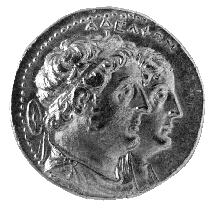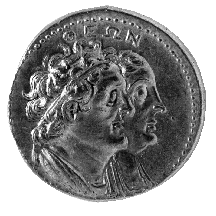



(56) Egypt, Ptolemy II - AV octodrachm, 260s B.C., 27.79 g. (inv.
91.098).
Obverse: Jugate busts r. of Ptolemy II, diademed and wearing
chlamys, and Arsinoe II, diademed and veiled; shield in l. field; ![]() : of the siblings.
: of the siblings.
Reverse: Jugate busts r. of Ptolemy I, wearing diadem and
aegis, and Berenike I, diademed and veiled; ![]() : of the gods.
: of the gods.
Provenance: Abner Kreisberg, 1972.
Bibliography: H. Troxell, "Arsinoë's Non-era,"
American Numismatic Society Museum Notes 28 (1983) 60-62; O. Mørkholm,
Early Hellenistic Coinage from the Accession of Alexander to the Peace
of Apamea (336-188 B.C.) (Cambridge 1991).
Ptolemy II Philadelphos (Brother-lover) succeeded his father, Ptolemy I,
and after their deaths deified his father and his mother, Berenike I. In
depicting himself and his sister-queen, Arsinoe, on the obverse and his
deified parents on the reverse of this octodrachm and on his tetradrachms,
he emphasized family resemblance and dynastic continuity. His marriage to
his sister scandalized Greeks, but brother-sister marriages were a custom
of the Egyptian pharaohs and the Ptolemies continued the tradition for generations.
The legends on the coin refer to the cult title of Ptolemy II and Arsinoe,
the "divine siblings." These coins were also struck by the successors
of Ptolemy II. The shield in the field of the obverse was added to the coins
of Ptolemy II minted in Alexandria and may have been his personal badge.
The queens of the Ptolemaic dynasty were often powerful and influential.
Arsinoe II had been married to Lysimachos of Thrace (see no. 45)
and her half-brother, Ptolemy Keraunos, before her marriage to Ptolemy II.
Known for her intelligence and ambition, she is credited with influencing
her husband's foreign affairs. When she died suddenly in 269 B.C., Ptolemy
II established a state cult for her and issued coins with her portrait.
Berenike did not participate in public affairs but her influence was nevertheless
significant. It was her son rather than Ptolemy's first-born son by his
previous marriage who succeeded to the throne, and after her death she received
her own temple at Alexandria, near the temple where she and Ptolemy were
worshipped together as Savior gods.
K.J.B.



All contents copyright (c) 1996.
Lawrence University
All rights reserved.